Publicité
Public infrastructure works at D’Entrecasteaux Street: rushing into trouble?
Par
Partager cet article
Public infrastructure works at D’Entrecasteaux Street: rushing into trouble?
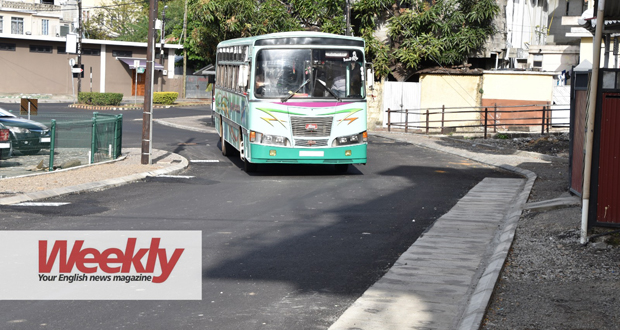

This article was published in Weekly No. 317 of 27 September 2018.
As Mauritius is under general construction, Weekly takes you to D’Entrecasteaux Street, one of the major roads leaving Port Louis southward, where the professed wish of the government to modernise our road infrastructure seems to have reached its limit. Lack of planning, half completed works, the question is: Did we rush into launching too many works simultaneously?
The prime minister, Pravind Jugnauth, repeated it himself several times: “Mauritius will be a big construction site in 2018.” And it’s fair to say that it is. From Rose Hill to Port Louis via Barkly, Grand River North West, Saint Louis and La Butte, bulldozers and excavators are busy clearing the land and drilling foundations to host the first phase of the Metro Express. At Caudan, the Decaën flyover is set to open to traffic by December; at Les Salines, the new access road to Fort William is scheduled for April 2019. The La Vigie-La Brasserie-Beaux Songes link road is also under construction. In Phoenix, the works for grade separated junctions at the Pont Fer, Dowlut and Jumbo roundabouts have started and will last for two years. On the M2 motorway, between Roche Bois and the Jin Fei Smart City, the construction of a third lane next to the existing two should be completed by the end of the year. Several road resurfacing works are also being undertaken all over the country.
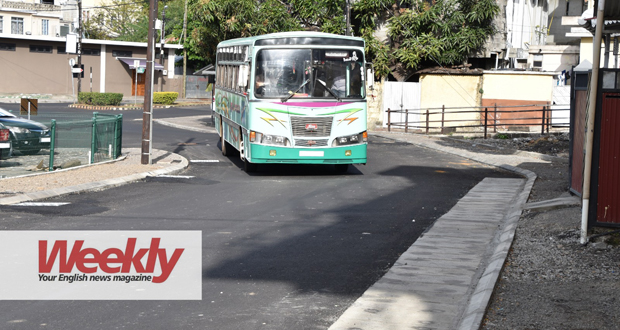
All seems set for a major modernisation and overhaul of our public road infrastructure. Yet, the government appears to have been so hasty in launching all these public infrastructure works simultaneously that some contractors do not seem to be able to follow the pace. The drainage and road surfacing works, part of the Decaën flyover project, at D’Entrecasteaux Street in Port Louis, represent a rather intriguing case in point. The contract was awarded to Transinvest Construction-General Construction and the works started in January.
Despite the works not being completed yet nine months on, the contractor has, we gather, already left the site to focus on another project it has been awarded: the access road to Fort William at Les Salines, due April 2019. The situation is rather alarming at D’Entrecasteaux Street. Only the first layer of asphalt has been applied. The manhole covers have been left dangerously protruding from the road, requiring road users, particularly motorcyclists and cyclists to zigzag between the various obstacles. Realising how dangerous the situation was, the contractor came up with an illusionary solution. Patches of tarmac have been spread grossly around the manhole covers to alleviate the threat. However, the assessment remains the same: road users still face serious road safety hazards with this amateurish solution.
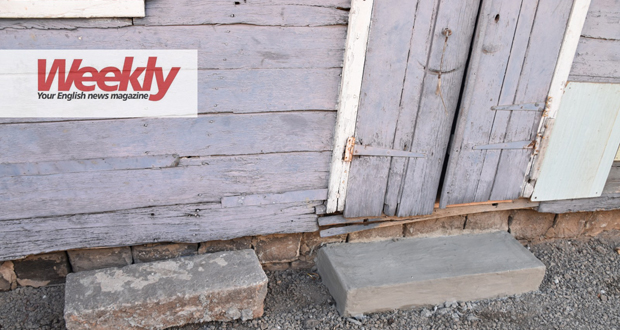
“The lack of planning and professionalism is baffling. We wonder if the contractor has been awarded too many projects and cannot follow the pace...”
Another nightmare for residents is the state of the pavement. One of the aims of the public works was to make the pavement level. At the moment, it is anything but, as the contractor has left rubble as surfacing for the pavement. As inhabitants put it, “It looks like a war zone.” Pedestrians could slip on the rubble at any time and seriously hurt themselves.
The drains are also problematic. Heavy concrete slabs, covered with equally massive ones, have replaced the cut stones which had covered the drains since colonial times. “When it rained, water used to flow from the Signal Mountain via the adjacent roads and into the drains. Now that the drains have been sealed off, we fear that, as the rainy season approaches, we might find our houses flooded,” say the inhabitants. All the more so as the drains and the pavements have been raised, such that some houses now find themselves below the drain and pavement level! Should the drains overflow, houses on the right-hand side of the road in the direction of the traffic will be the first ones flooded. “The lack of planning and professionalism is baffling,” laments I.R., a resident, “We wonder if the contractor has been awarded too many projects and cannot follow the pace...”
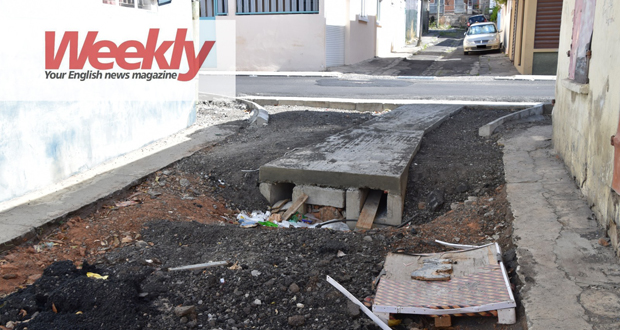
“D’Entrecasteaux Street is a busy narrow road used by buses and heavy vehicles. Now imagine having two moving vehicles abreast. It’s a recipe for disaster.”
The residents and business owners of D’Entrecasteaux Street are also up in arms against the conversion of the current one-lane street into a double-lane one, with on-road parking prohibited. A.T., who owns a family business, is revolted. “How can you run a small business if your customers cannot even park?” Others are concerned by the road safety threats this measure will result in. “As you can see, it’s a busy narrow road used by buses and heavy vehicles. Now imagine having two moving vehicles abreast. It’s a recipe for disaster,” warns L.P., a resident.
Contacted for a reaction, Transinvest told us they were “working on a reply” which was yet to come as we went to press [as at 19 October, no reply has yet been received – Ed.]. The Road Development Authority (RDA) was unavailable for a reaction, while the Ministry of Public Infrastructure and the Traffic Management and Road Safety Unit (TMRSU) both claimed they were “unaware” of the situation at D’Entrecasteaux Street, with the ministry declaring that there were “so many works going on at the moment”.
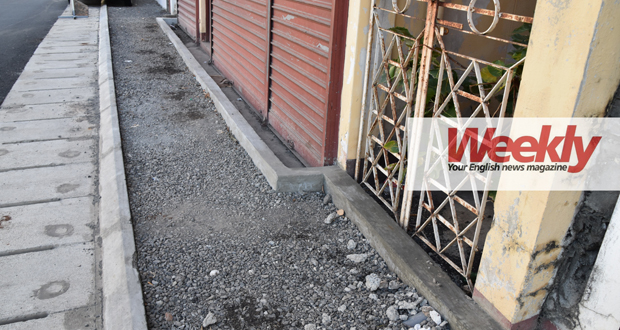
The press attaché of Alain Wong, minister of social integration and government MP for constituency No. 1 (Grand River North West-Port Louis West), told Weekly she would get back to us but we are still waiting [The press attaché eventually emailed us on Thursday 27 September, after the article was published, claiming she tried contacting us by phone the whole week. She added that a meeting between Minister Alain Wong and the inhabitants would be held “soon” – Ed.]. Wong’s constituency colleague, Patrice Armance, from the Parti Mauricien Social Démocrate (PMSD), was more loquacious and disclosed that he had contacted the minister of public infrastructure, Nando Bodha, in vain. “A question to the minister is already lined up for when parliament resumes in October,” reveals Armance.
It remains obscure whether the “big construction site” announced by the government for 2018 was well-planned. Meanwhile, the inhabitants of D’Entrecasteaux Street have a simple message for the authorities: “Complete the long overdue works right now!”
Road infrastructure procurement: Transinvest tops the list in 2018
According to figures from the Public Procurement Portal, Transinvest is the construction company which has, as at August, been awarded the greatest number of road infrastructure contracts in 2018, both numerically (26) and financially (Rs4 billion), ahead of Gamma Construction (24 awards worth Rs247 million), Best Construct (11 awards worth Rs164.5 million), General Construction (11 awards worth Rs105.8 million), Pad Co (six awards worth Rs42.8 million) and Rehm Grinaker (one award worth Rs55.8 million).
Transinvest has, amongst others, won the juicy contracts of the grade separated junctions at the Pont Fer/Jumbo/Dowlut roundabouts in Phoenix at Rs3.6 billion and the Cap Malheureux bypass at Rs168.8 million. Seventy four of the 79 above-mentioned procurement awards relate to the framework agreement for road maintenance and minor works 2017-2020 which involves routine works like the resurfacing of roads, the construction of footpaths and drains, the geometric realignment of roads and so on.
Who was D’Entrecasteaux?
Joseph Antoine Raymond Bruni D’Entrecasteaux was an admiral and navigator born in Aix, France in 1739. He joined the navy at fifteen during the Seven Years’ War, and eventually made a name in hydrography while serving in the Mediterranean and Indian Oceans. D’Entrecasteaux then acted as governor of Isles de France and Bourbon (present-day Mauritius and Reunion) from 1787 to 1789.
D’Entrecasteaux is however mainly remembered for his voyage in 1791 to Oceania to search for the missing French naval officer Lapérouse and to make scientific discoveries and surveys. Accompanied by other fellow scientists, he charted the cartography of the regions he visited and wrote details anthropological reports of their inhabitants. He passed away in July 1793, off New Guinea, at the age of 55.
Besides D’Entrecasteaux Street in Mauritius, Bruni D’Entrecasteaux’s name was given to, amongst others, a nature park in western Australia, a channel between Bruni island and the south east coast of mainland Tasmania, islands in Papua New Guinea and a class of French navy patrol ships.
For more views and in-depth analysis of current issues, Weekly magazine (Price: Rs 25) or subscribe to Weekly for Rs110 a month. (Free delivery to your doorstep). Email us on: weekly@lexpress.mu
Publicité
Publicité
Les plus récents






